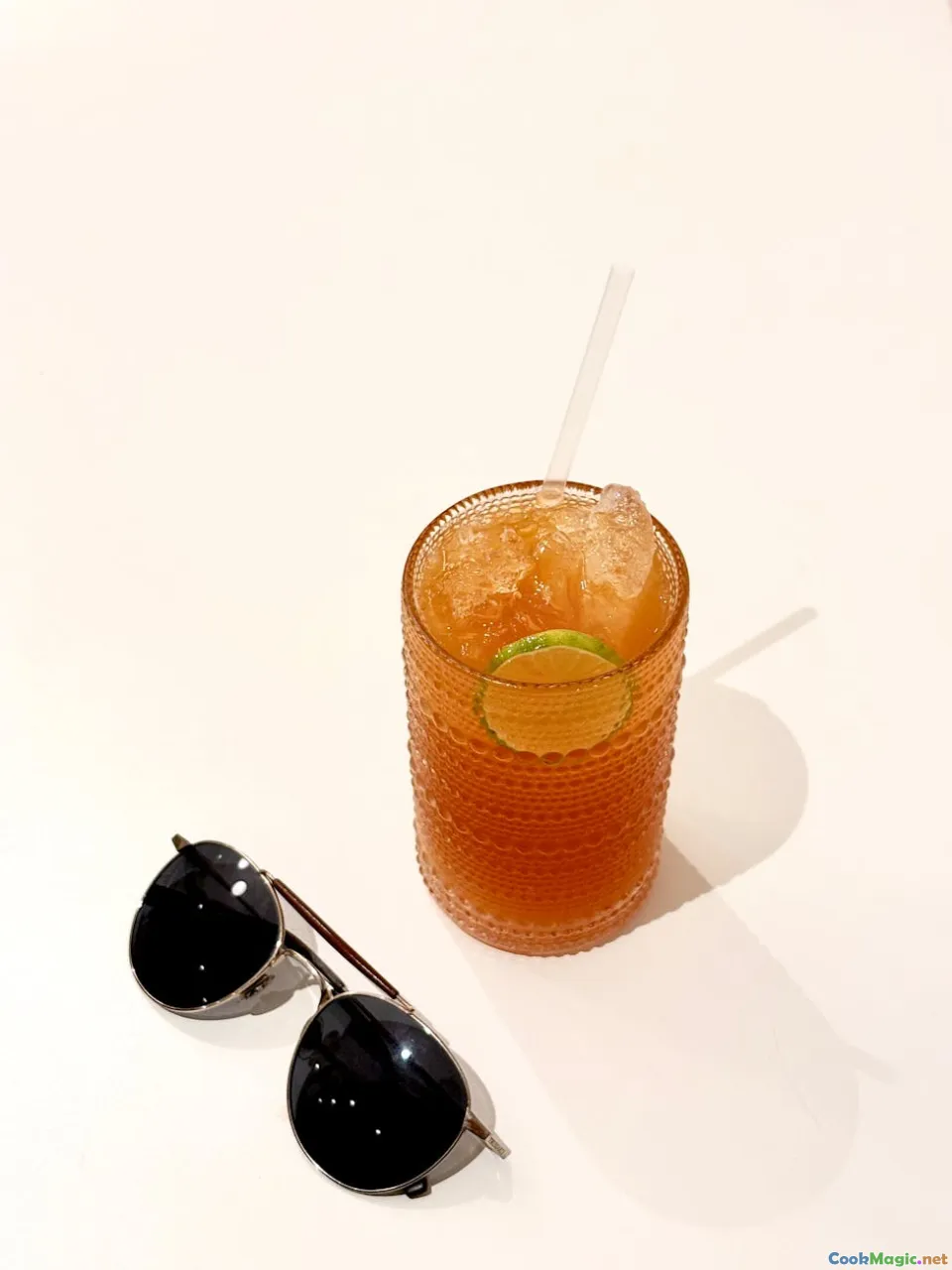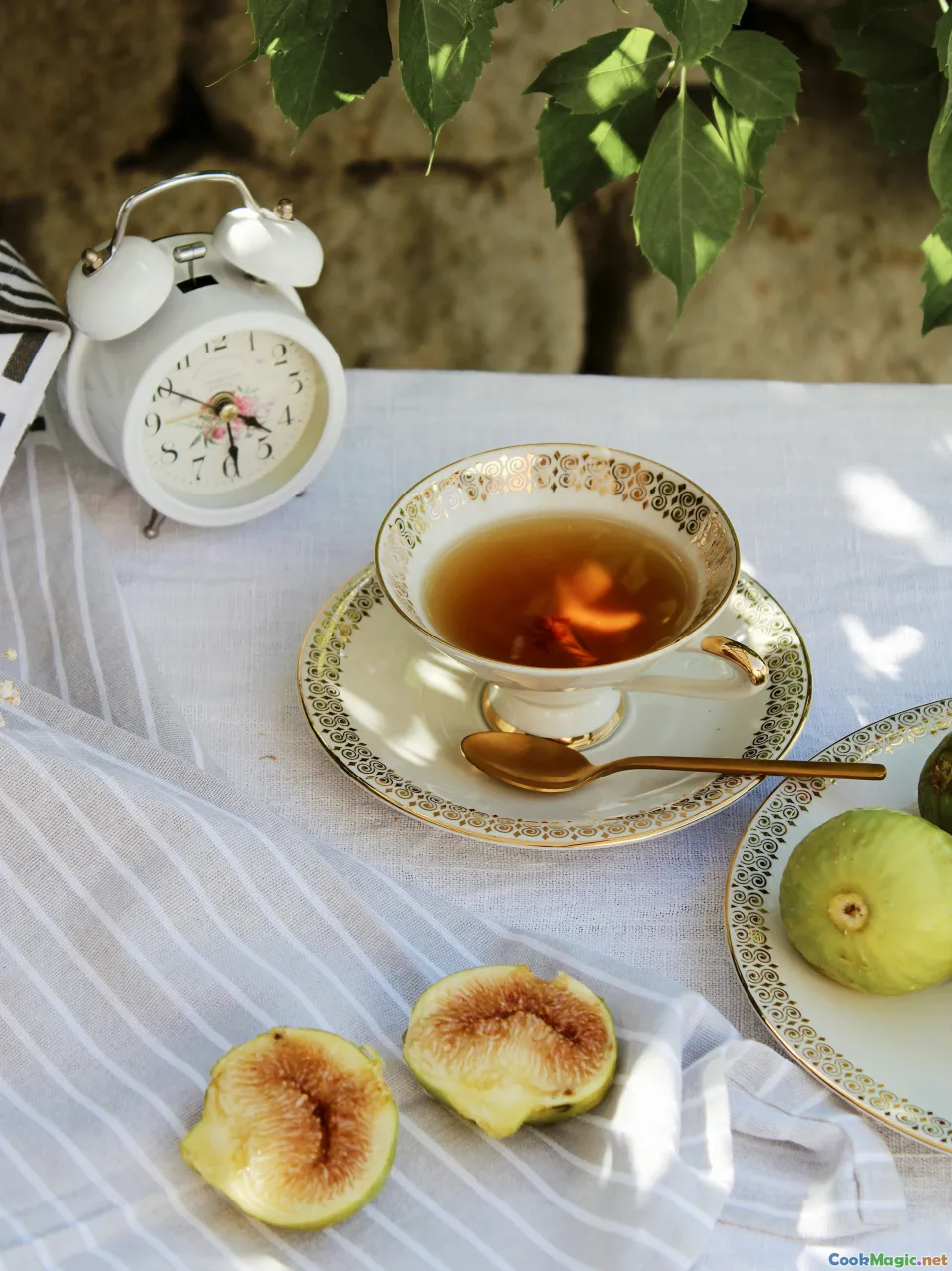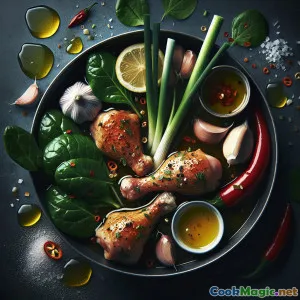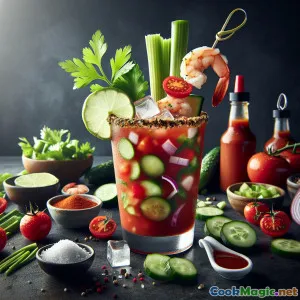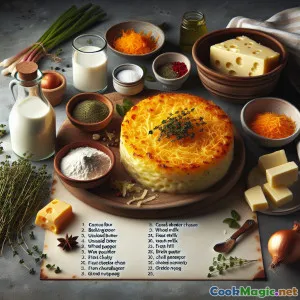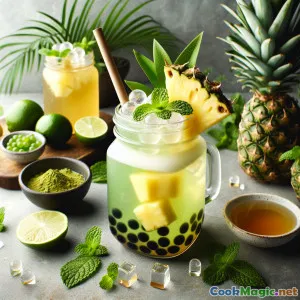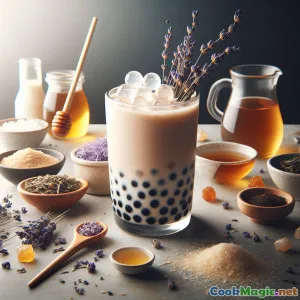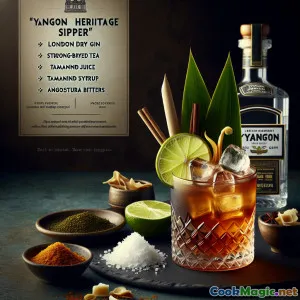
Yangon Heritage Sipper: Colonial Tea Cocktail
(0 Reviews)Ingredients
-
60 ml London Dry Gin
(Provides traditional English base)
-
120 ml Strong brewed Myanmar black tea
(Chilled; use robust loose-leaf if available)
-
20 ml Fresh Lime Juice
(Adds citrus brightness)
-
15 ml Tamarind syrup
(Sweet-sour complexity; substitute with simple syrup plus a dash of lemon juice if needed)
-
2 dashes Angostura bitters
(Optional, adds extra depth)
-
1 cup Crushed Ice
(For serving)
-
1 small leaf Pandan leaf
(For aromatic garnish, tie in a knot)
-
2 slices Lime wheel
(For garnish)
(Provides traditional English base)
(Chilled; use robust loose-leaf if available)
(Adds citrus brightness)
(Sweet-sour complexity; substitute with simple syrup plus a dash of lemon juice if needed)
(Optional, adds extra depth)
(For serving)
(For aromatic garnish, tie in a knot)
(For garnish)
Nutrition
- Servings: 2
- Serving Size: 1 glass (180ml)
- Calories: 120 kcal
- Carbohydrates: 0 g
- Protein: 0.8 g
- Fat: 0.2 g
- Fiber: 0.4 g
- Sugar: 7 g
- Sodium: 5 mg
- Cholesterol: 0 mg
- Calcium: 7 mg
- Iron: 0.1 mg
Instructions
-
1 - Brew Tea:
Steep 1 tbsp robust Myanmar (or English breakfast) tea leaves in 150ml boiling water for 4–5 minutes. Strain, chill until cold.
-
2 - Prepare Syrup:
Mix tamarind paste with an equal part hot water and ½ tsp sugar. Stir, cool, then measure out 15ml.
-
3 - Mix Drink:
Fill a cocktail shaker two-thirds with crushed ice. Add gin, chilled tea, lime juice, tamarind syrup, and bitters (if using). Shake vigorously.
-
4 - Strain and Serve:
Strain into glasses filled with fresh crushed ice. Garnish each with a lime wheel and tied pandan leaf (if using) atop the glass.
Steep 1 tbsp robust Myanmar (or English breakfast) tea leaves in 150ml boiling water for 4–5 minutes. Strain, chill until cold.
Mix tamarind paste with an equal part hot water and ½ tsp sugar. Stir, cool, then measure out 15ml.
Fill a cocktail shaker two-thirds with crushed ice. Add gin, chilled tea, lime juice, tamarind syrup, and bitters (if using). Shake vigorously.
Strain into glasses filled with fresh crushed ice. Garnish each with a lime wheel and tied pandan leaf (if using) atop the glass.
More About: Yangon Heritage Sipper: Colonial Tea Cocktail
Yangon Heritage Sipper: Summoning Yangon in a Glass
The Yangon Heritage Sipper is a drink born from a crossroads—the British colonial threads woven deep into Myanmar’s (Burma’s) graceful tea tradition. This drink merges meticulously brewed robust black tea, reminiscent of daily Burmese teatime, with the crisp snap of classic London dry gin.
History and Inspirations
Gin and tea have shared roots long before this cocktail. Gin, from the heart of the British Isles, and tea, an ancient Asian delight, converged especially when the British Empire stretched its influences through the Asian continent—including what is now Myanmar. Myanmar’s own tea houses are social institutions, with hundreds of stalls lining lanes and neighborhoods in Yangon. Traditionally, visitors enjoy strong, malty tea, often sweet or spiked with condensed milk.
The Yangon Heritage Sipper resurrects this connection in a self-conscious, celebratory fashion. By combining gin with strong, unsweetened black tea, this drink recalls evenings in colonial-era hotels—think teak interiors, lazy ceiling fans, and chatter that mingled Rangoon’s cosmopolitan whispers with resolute English accents. The use of tamarind syrup introduces a distinctly Southeast Asian sweet-sour tang, echoing condiments, beverages, and desserts familiar across Myanmar.
Creative Twists and Unique Aspects
-
Tamarind Syrup: Instead of plain sugar or honey, a tamarind syrup adds unexpected tropical depth—at once tart, fruity, and just sweet enough.
-
Pandan & Lime: Burmese (and Southeast Asian) drinks often mix sweet and herbal or citrusy elements. Tying a pandan leaf for the garnish summons a leaf-green, vanilla-like aroma upon lifting the cup—utterly transporting.
-
Fusion Vibe: This isn’t a classic British tea cocktail (like a traditional Gin and It), nor is it an exact Burmese cha—this recipe sits at a dapper, East-meets-West intersection, deservedly cosmopolitan.
Suggestions, Pairings, and Notes
-
Tea: Use loose-leaf Myanmar black if you can source it. If not, an assertive Assam or English breakfast varietal is fitting.
-
Tamarind Substitute: If tamarind syrup isn’t handy or desired, a peppery ginger syrup or even orange marmalade thinned with lime juice gives a similarly vibrant intrigue.
-
Non-alcoholic Option: For teetotalers, omit the gin and double the strength of the tea; use honey-ginger syrup in lieu of tamarind for a bespoke ‘cold comfort’ mocktail.
-
Ice: The texture of good crushed ice adds flair here, both chilling and mellowing the more potent notes. Enjoy this indoors or out—ideally with long conversations or shared sunset moments.
-
Cultural Notes: Drinks like this underscore the bittersweet syncretism of colonial heritage—the ability to turn ingredients and expectations upside-down. The Sipper invites reflections not just on culinary inheritance—on flavor diplomacy, adaptation, and the living rapport between Myanmar and Britain.
-
Service Suggestions: Serve in chilled rocks glasses, almost brimming, garnish balanced like offering fragrant blessings from each garnish.
Personal Thoughts
Creating this drink connects more than stations on a map; it’s about the creative conversations possible between vastly different traditions. Readers can take a standard-fare gin-and-tonic menu and—with a few more ingredients and a willingness to explore—spin tales of trade journeys, bustling night markets, aged but lively hotels, and the collision of tropical warmth with cool colonial nostalgia. The Yangon Heritage Sipper stands as an original tribute, beautiful in both color and story.
In every sip, feel Yangon’s sun-drenched boulevards and the clink-glass lore of English drawing rooms—all marbled over crushed ice. Cheers to discovery!

